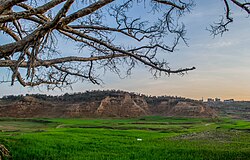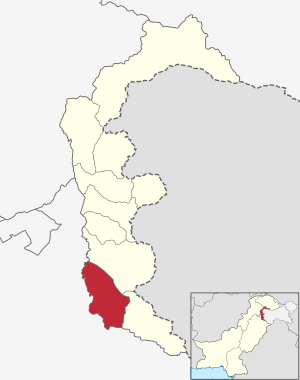Mirpur District (Urdu: ضلع میرپور) is a district of Pakistan-administered Azad Jammu and Kashmir region.[1] It is one of the 10 districts of Pakistan's territory of Azad Kashmir.[3] The Mirpur District is bounded on the north by the Kotli District, on the east by the Bhimber District, on the south by the Gujrat District of Punjab, Pakistan, on the south-west by the Jhelum District of Punjab, Pakistan, and on the west by its Rawalpindi District. The district is named after its main city, Mirpur. The Mirpur District has a population of 456,200[4] and covers an area of 1,010 km2 (390 sq mi). The district is mainly mountainous with some plains. The Mirpur District has a humid subtropical climate[5] which closely resembles that of the Gujrat District and the Jhelum District, the adjoining districts of Pakistan's Punjab Province.
Mirpur District
ضلع میرپور | |
|---|---|
District of Azad Kashmir administered by Pakistan[1] | |
 Mirpur is the capital of Mirpur district | |
 Interactive map of Mirpur district | |
![Pakistani-administered Azad Kashmir (shaded in green) in the disputed Kashmir region[1]](http://up.wiki.x.io/wikipedia/commons/thumb/8/84/Kashmir_region._LOC_2003626427_-_showing_sub-regions_administered_by_different_countries.jpg/250px-Kashmir_region._LOC_2003626427_-_showing_sub-regions_administered_by_different_countries.jpg) | |
| Coordinates (Mirpur, Azad Kashmir): 33°9′0″N 73°44′0″E / 33.15000°N 73.73333°E | |
| Administering country | Pakistan |
| Territory | Azad Kashmir |
| Division | Mirpur Division |
| Headquarters | Mirpur |
| Government | |
| • Type | District Administration |
| • Deputy Commissioner | N/A |
| • District Police Officer | N/A |
| • District Health Officer | N/A |
| Area | |
• Total | 1,010 km2 (390 sq mi) |
| Population (2017) | |
• Total | 456,200 |
| • Density | 452/km2 (1,170/sq mi) |
| Languages | |
| • Official | Urdu[2] |
| • Spoken | |
| Number of Tehsils | 2 |

History
editDuring the British Raj, the Mirpur District was one of the five districts of the Jammu Province in the princely state of Jammu and Kashmir.[6][7] According to the 1941 census, the it had a population of 386,655, roughly 80% of whom were Muslim and 16% of whom were Hindu.[8] It consisted of three tehsils: the Bhimber Tehsil, the Kotli Tehsil, and the Mirpur Tehsil.[9] The Bhimber Tehsil and the Kotli Tehsil were subsequently promoted to district status. The three districts presently constitute the Mirpur Division of Azad Kashmir. Small portions of the former Mirpur District were included in the Rajouri District of Indian-administered Jammu and Kashmir.
The original Mirpur District, along with the Poonch District and the Rajouri District, had close geographic, ethnic, and cultural ties with the West Punjab area, more so than with the city of Jammu and the rest of the Jammu Province. Due to those reasons, scholar Christopher Snedden stated that the people of Mirpur area had a strong desire to join Pakistan during the partition.[10]
In November 1947, the Mirpur District was the site of the Mirpur Massacre, where many Hindus, Sikhs, and refugees from the partition, were killed by armed Pakistani tribesmen and soldiers.[11]
Language and ethnicity
editThe main language, native to an estimated 85% of the district's population,[12] is known under a number of sometimes ambiguous names. Its speakers call it with various names: Pahari, Mirpur Pahari, Mirpuri, and Pothwari,[13] while some label it as Punjabi.[14] Sociolinguists have regarded it as one of the three major dialects of the Pahari-Pothwari language complex,[15] which is intermediate between Lahnda and Punjabi.[16] Mirpur Pahari is mutually intelligible with the other two major dialects – Pothwari of the Potohar Plateau in the Punjab Province and the Pahari spoken to the north in Azad Kashmir and around Murree – and shares with them between 77% and 84% of its basic vocabulary,[17] although the difference with the northernmost varieties (in Muzaffarabad) is sufficient to impede understanding.[18] Mirpuri speakers have a strong sense of Kashmiri identity that takes precedence over linguistic identification with closely related groups outside of Azad Kashmir, such as the Punjabis of the Pothohar.[19][20]
The Gujari language is spoken by an estimated 10% of the population.[12] The local dialect is closely related to the Gujari varieties spoken in the rest of Azad Kashmir and in the Hazara region.[21] Other languages spoken include Urdu and English.
Government
editThe district is administratively subdivided into two tehsils:[22]
Villages
editNotable villages in the district include:
Dadyal Tehsil
editMirpur Tehsil
editReferences
edit- ^ a b c The application of the term "administered" to the various regions of Kashmir and a mention of the Kashmir dispute is supported by the tertiary sources (a) through (e), reflecting due weight in the coverage. Although "controlled" and "held" are also applied neutrally to the names of the disputants or to the regions administered by them, as evidenced in sources (h) through (i) below, "held" is also considered politicized usage, as is the term "occupied," (see (j) below).
(a) Kashmir, region Indian subcontinent, Encyclopaedia Britannica, retrieved 15 August 2019 (subscription required) Quote: "Kashmir, region of the northwestern Indian subcontinent ... has been the subject of dispute between India and Pakistan since the partition of the Indian subcontinent in 1947. The northern and western portions are administered by Pakistan and comprise three areas: Azad Kashmir, Gilgit, and Baltistan, the last two being part of a territory called the Northern Areas. Administered by India are the southern and southeastern portions, which constitute the state of Jammu and Kashmir but are slated to be split into two union territories.";
(b) Pletcher, Kenneth, Aksai Chin, Plateau Region, Asia, Encyclopaedia Britannica, retrieved 16 August 2019 (subscription required) Quote: "Aksai Chin, Chinese (Pinyin) Aksayqin, portion of the Kashmir region, at the northernmost extent of the Indian subcontinent in south-central Asia. It constitutes nearly all the territory of the Chinese-administered sector of Kashmir that is claimed by India to be part of the Ladakh area of Jammu and Kashmir state.";
(c) "Kashmir", Encyclopedia Americana, Scholastic Library Publishing, 2006, p. 328, ISBN 978-0-7172-0139-6 C. E Bosworth, University of Manchester Quote: "KASHMIR, kash'mer, the northernmost region of the Indian subcontinent, administered partlv by India, partly by Pakistan, and partly by China. The region has been the subject of a bitter dispute between India and Pakistan since they became independent in 1947";
(d) Osmańczyk, Edmund Jan (2003), Encyclopedia of the United Nations and International Agreements: G to M, Taylor & Francis, pp. 1191–, ISBN 978-0-415-93922-5 Quote: "Jammu and Kashmir: Territory in northwestern India, subject to a dispute between India and Pakistan. It has borders with Pakistan and China."
(e) Talbot, Ian (2016), A History of Modern South Asia: Politics, States, Diasporas, Yale University Press, pp. 28–29, ISBN 978-0-300-19694-8 Quote: "We move from a disputed international border to a dotted line on the map that represents a military border not recognized in international law. The line of control separates the Indian and Pakistani administered areas of the former Princely State of Jammu and Kashmir.";
(f) Skutsch, Carl (2015) [2007], "China: Border War with India, 1962", in Ciment, James (ed.), Encyclopedia of Conflicts Since World War II (2nd ed.), London and New York: Routledge, p. 573, ISBN 978-0-7656-8005-1,The situation between the two nations was complicated by the 1957–1959 uprising by Tibetans against Chinese rule. Refugees poured across the Indian border, and the Indian public was outraged. Any compromise with China on the border issue became impossible. Similarly, China was offended that India had given political asylum to the Dalai Lama when he fled across the border in March 1959. In late 1959, there were shots fired between border patrols operating along both the ill-defined McMahon Line and in the Aksai Chin.
(g) Clary, Christopher (2022), The Difficult Politics of Peace: Rivalry in Modern South Asia, Oxford and New York: Oxford University Press, p. 109, ISBN 9780197638408,Territorial Dispute: The situation along the Sino-Indian frontier continued to worsen. In late July (1959), an Indian reconnaissance patrol was blocked, "apprehended," and eventually expelled after three weeks in custody at the hands of a larger Chinese force near Khurnak Fort in Aksai Chin. ... Circumstances worsened further in October 1959, when a major class at Kongka Pass in eastern Ladakh led to nine dead and ten captured Indian border personnel, making it by far the most serious Sino-Indian class since India's independence.
(h) Bose, Sumantra (2009), Kashmir: Roots of Conflict, Paths to Peace, Harvard University Press, pp. 294, 291, 293, ISBN 978-0-674-02855-5 Quote: "J&K: Jammu and Kashmir. The former princely state that is the subject of the Kashmir dispute. Besides IJK (Indian-controlled Jammu and Kashmir. The larger and more populous part of the former princely state. It has a population of slightly over 10 million, and comprises three regions: Kashmir Valley, Jammu, and Ladakh.) and AJK ('Azad" (Free) Jammu and Kashmir. The more populous part of Pakistani-controlled J&K, with a population of approximately 2.5 million.), it includes the sparsely populated "Northern Areas" of Gilgit and Baltistan, remote mountainous regions which are directly administered, unlike AJK, by the Pakistani central authorities, and some high-altitude uninhabitable tracts under Chinese control."
(i) Fisher, Michael H. (2018), An Environmental History of India: From Earliest Times to the Twenty-First Century, Cambridge University Press, p. 166, ISBN 978-1-107-11162-2 Quote: "Kashmir’s identity remains hotly disputed with a UN-supervised “Line of Control” still separating Pakistani-held Azad (“Free”) Kashmir from Indian-held Kashmir.";
(j) Snedden, Christopher (2015), Understanding Kashmir and Kashmiris, Oxford University Press, p. 10, ISBN 978-1-84904-621-3 Quote:"Some politicised terms also are used to describe parts of J&K. These terms include the words 'occupied' and 'held'." - ^ "Kashmir". 20 June 2023.
- ^ - Government Website
- ^ "Census 2017: AJK population rises to over 4m". The Nation. Retrieved 2017-09-01.
- ^ "Updated world map of the Köppen-Geiger climate classification" (PDF). Retrieved 2023-08-27.
- ^ Karim 2013, pp. 29–32.
- ^ Behera 2007, p. 15.
- ^ Snedden 2001, p. 118.
- ^ Snedden 2001, p. 112.
- ^ Snedden 2001, p. 120.
- ^ "November 25, 1947 Mirpur massacre: An ill-fated day that reminds us of injustice and infringement, brutality and bloodshed".
- ^ a b Shakil 2012.
- ^ Lothers & Lothers 2010, pp. 2–3, 5, 19, 100.
- ^ Lothers & Lothers 2010, p. 44.
- ^ Lothers & Lothers 2010, p. 2.
- ^ Shackle 1979, p. 201.
- ^ Lothers & Lothers 2010, pp. 2, 24.
- ^ Lothers & Lothers 2010, p. 86.
- ^ Shackle 2007, p. 114.
- ^ Sonstige., Joseph C., Mathew 1966- (2017). Understanding Pakistan : emerging voices from india. Routledge. ISBN 978-1-138-23490-1. OCLC 991571023.
{{cite book}}: CS1 maint: multiple names: authors list (link) CS1 maint: numeric names: authors list (link) - ^ Hallberg & O'Leary 1992, pp. 111–12. The variety surveyed is from Kotli, to the north of Mirpur District
- ^ "Tehsils of Mirpur District on AJK map". ajk.gov.pk. AJK Official Portal. Retrieved 18 November 2019.
Bibliography
edit- Behera, Navnita Chadha (2007). Demystifying Kashmir. Pearson Education India. ISBN 978-8131708460.
- Hallberg, Calinda E.; O'Leary, Clare F. (1992). "Dialect Variation and Multilingualism among Gujars of Pakistan". In O'Leary, Clare F.; Rensch, Calvin R.; Hallberg, Calinda E. (eds.). Hindko and Gujari. Sociolinguistic Survey of Northern Pakistan. Islamabad: National Institute of Pakistan Studies, Quaid-i-Azam University and Summer Institute of Linguistics. pp. 91–196. ISBN 969-8023-13-5.
- Karim, Maj Gen Afsir (2013). Kashmir The Troubled Frontiers. Lancer Publishers LLC. pp. 29–32. ISBN 978-1-935501-76-3.
- Lothers, Michael; Lothers, Laura (2010). Pahari and Pothwari: a sociolinguistic survey (Report). SIL Electronic Survey Reports. Vol. 2010–012.
- Shackle, Christopher (1979). "Problems of classification in Pakistan Panjab". Transactions of the Philological Society. 77 (1): 191–210. doi:10.1111/j.1467-968X.1979.tb00857.x. ISSN 0079-1636.
- Shackle, Christopher (2007). "Pakistan". In Simpson, Andrew (ed.). Language and national identity in Asia. Oxford linguistics Y. Oxford University Press. ISBN 978-0-19-922648-1.
- Shakil, Mohsin (2012). "Languages of Erstwhile State of Jammu Kashmir (A Preliminary Study)". p. 12.
- Snedden, Christopher (2001). "What happened to Muslims in Jammu? Local identity, '"the massacre" of 1947' and the roots of the 'Kashmir problem'". South Asia: Journal of South Asian Studies. 24 (2): 111–134. doi:10.1080/00856400108723454. S2CID 143991832.